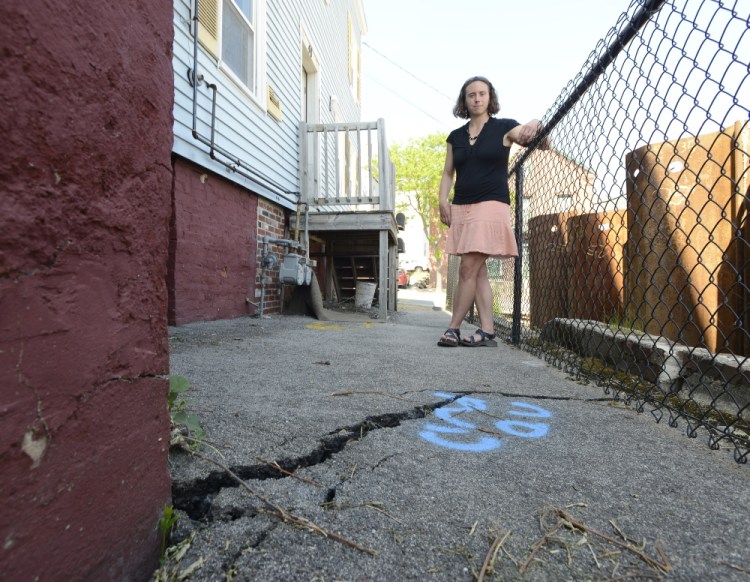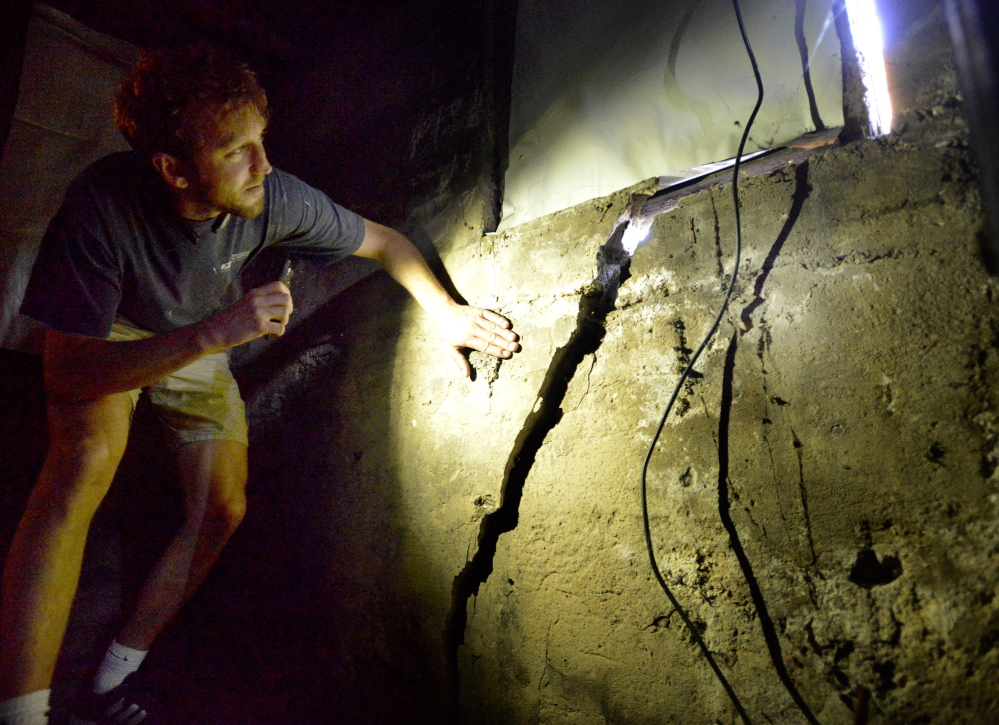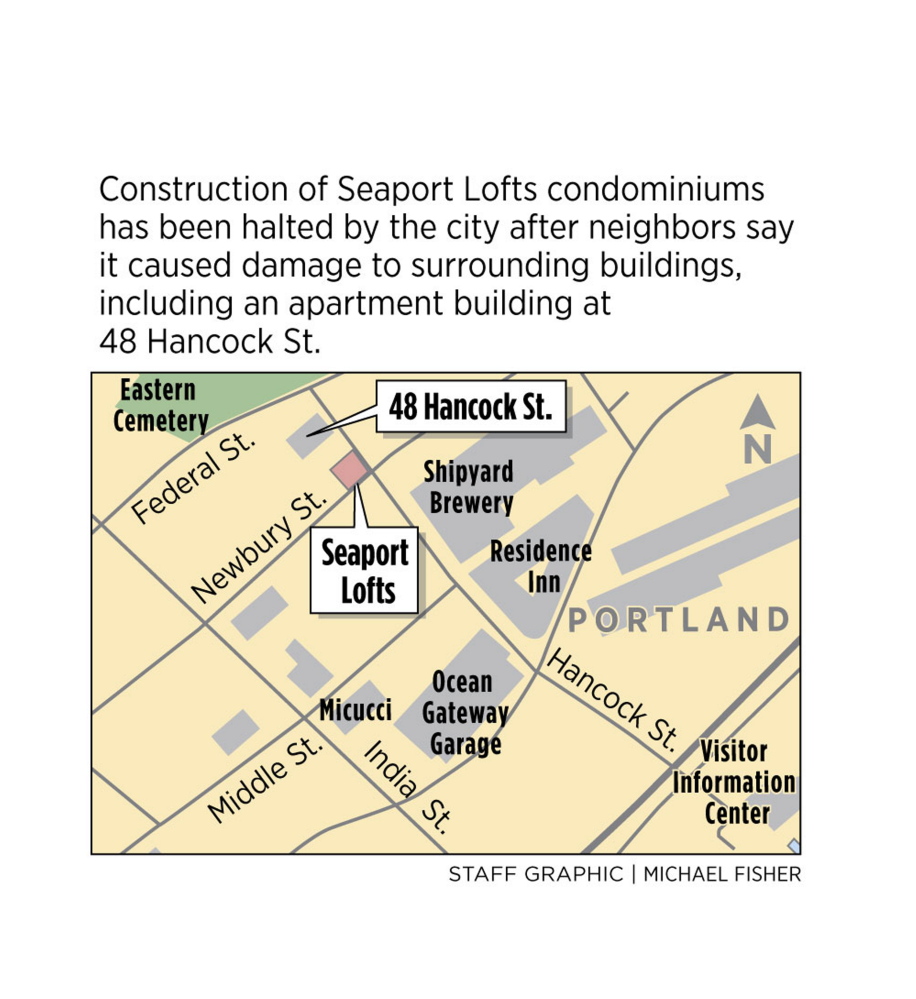Liv Chase was standing in the backyard of the building she owns at 48 Hancock St. last month, watching the construction of a new condominium complex, when crews began to remove large sheets of metal that had been holding back the earth from a new retaining wall.
The ground began to move, Chase said, describing it as an earthquake. “I almost fell down because there was so much vibration,” she said.
Jerry Phair, 44, was inside his first-floor apartment and said he felt the two-family building shake when the new retaining wall collapsed and caused a portion of the building to sink.
“Everything started falling off of the shelves,” including books and dishes, Phair said. “Now the windows don’t shut and the doors don’t shut. You really have to force them.”
Construction work on the condo project, called Seaport Lofts, has been shut down since reports of large cracks and other damage to Chase’s building and others prompted an unusual stop-work order from the city on April 13. On Tuesday, the city notified neighbors that it has requested an engineering study as part of a plan to secure the site before work can resume.
Stop-work orders are routinely issued when people build without a permit or exceed the scope of the permit, city officials say. However, they say it’s rare that one is issued because of damage to neighboring buildings.
The city’s hot real estate market could change that.
As the city runs out of vacant land to be developed, and as buyers and renters seek out urban neighborhoods and lifestyles, more development is taking place in established neighborhoods such as those on Portland’s East End. That sometimes means squeezing projects onto small lots between houses that date to the early 1900s, potentially decreasing the margin for error.
Jeff Levine, the city’s director of planning and urban development, isn’t sure whether neighbors of other projects will experience more collateral damage as development moves deeper into established neighborhoods. And he said the age of Portland’s existing housing doesn’t add to the risk.
“Older buildings are not necessarily any less sturdy than new ones,” Levine said.
FOUNDATION SPLITS, STAIRS DETACH, WALLS CRACK
The Seaport Lofts on Newbury Street was approved by the Planning Board in October 2013. It promised to add 39 condominiums, including seven townhouses, in the India Street neighborhood, which is undergoing a flurry of development activity.
The lofts are the second phase of the Bay House, an 86-unit condominium project at the corner of Hancock and Newbury that was completed in 2013.
On Wednesday, Chase and her partner, Brent Adler, who own 23 rental units in four buildings, showed the Press Herald some of the damage caused when the retaining wall collapsed. In the basement, a cement foundation was split apart, allowing sunshine and a warm breeze to come through. An outdoor staircase was separated from the wall, and interior walls were cracked.
Levine said in an email Wednesday that the stop-work order was issued after the city received complaints from people living in the Federal Street Townhouses who reported damage to their decks and interior drywall cause by soil movement.
Hugh Nazor, president of the India Street Neighborhood Association, said four townhouses there were damaged, as well as two houses on the corner of Federal and Hancock streets.
The city informed the developer May 19 that it needed to hire a professional engineer and “submit a fully engineered action plan to address structural failure and proposed mitigation measures.” That plan also needs to be peer-reviewed.
“We are not getting ready to lift the stop-work order yet,” said Jessica Grondin, the city’s communications director. “We’re still waiting for the fully engineered action plan to address the structural failures.”
ENGINEERS WORKING TO REMEDY PROBLEM
One of the developers, Demetri Dasco, said developers are working with a team of engineers to evaluate what went wrong and to develop a plan to prevent it from happening again. He was hoping a plan would be approved within the next few days.
Dasco said the engineers are looking at ways to shore up the development site and the ground around neighboring buildings.
“Once we figure out a solution we’re going to make it right,” Dasco said. “Any damage that was caused by (the ground settling), as the developer, we’re obviously responsible and we would evaluate that and we would fix it.”
Meanwhile, city officials have informed the neighbors that the city isn’t responsible for the damage.
“Damage caused by the developer or its contractor to neighboring properties is a matter to be addressed privately between those parties,” the city’s letter to neighbors states. “The developer therefore proceeds at its own risk and it will bear any and all responsibility for damages caused as a result of its actions.”
Chase had bought the Hancock Street house with the intention of renovating or rebuilding on the site. Now she is not so sure that the ground will be stable enough to support redevelopment. She said the abutters have hired their own structural engineer to survey the extent of the damage.
Chase said her building, which dates to 1895, dropped several inches as the ground shifted beneath her.
“We’re all pretty upset about what happened,” she said.
Copy the Story LinkSend questions/comments to the editors.






Success. Please wait for the page to reload. If the page does not reload within 5 seconds, please refresh the page.
Enter your email and password to access comments.
Hi, to comment on stories you must . This profile is in addition to your subscription and website login.
Already have a commenting profile? .
Invalid username/password.
Please check your email to confirm and complete your registration.
Only subscribers are eligible to post comments. Please subscribe or login first for digital access. Here’s why.
Use the form below to reset your password. When you've submitted your account email, we will send an email with a reset code.